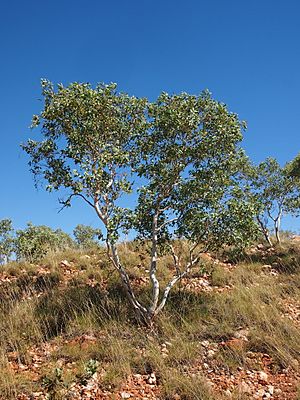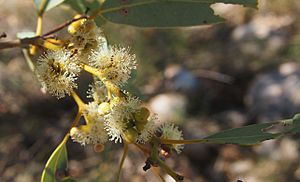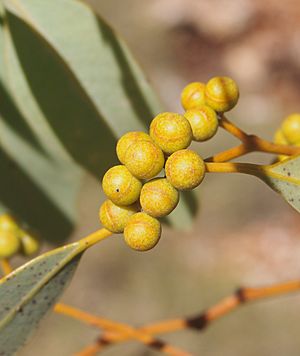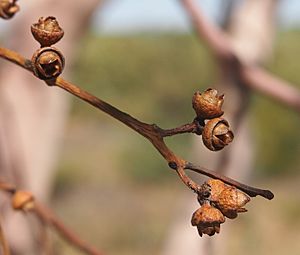Migum facts for kids
Quick facts for kids Migum |
|
|---|---|
 |
|
| Scientific classification | |
| Genus: |
Eucalyptus
|
| Species: |
leucophloia
|
The snappy gum or migum (scientific name: Eucalyptus leucophloia) is a type of small tree or mallee found only in northern Australia. Local Indigenous groups have different names for it. The Mangarayi and Yangman people call it mirndir. The Ngarluma people know it as malygan, and the Yindjibarndi people call it majgan.
This tree has smooth, powdery bark. Its adult leaves are shaped like a spear or an egg. Its flower buds usually grow in groups of seven. The flowers are white, and the fruit looks like a cup, barrel, or half-sphere.
Contents
What it Looks Like
The snappy gum is a mallee (a shrubby tree with many stems) or a small tree. It can grow from about 2.5 to 10 meters (8 to 33 feet) tall. It has a special woody swelling at its base called a lignotuber. This helps it regrow after fires.
Bark and Trunk
The new bark of the snappy gum is light pink or orange. As it gets older, it turns white. Then, it can change to dark pink or grey in patches. The main trunk is often bent and can be about 40 centimeters (16 inches) wide at the bottom. The tree's top part (its crown) is usually as wide as the tree is tall. It has many leaves, making a moderately thick cover.
Leaves
Young snappy gum plants and new shoots have stems that are often a pale, bluish-green color (this is called glaucous). These stems are somewhat square with a small wing on each corner. Their leaves are egg-shaped or nearly round, about 32 to 70 millimeters long and 30 to 85 millimeters wide.
Adult leaves grow one after another along the stem. They are a dull green to grey-green color on both sides. They are about 50 to 120 millimeters long and 10 to 40 millimeters wide. Each leaf tapers down to a stalk called a petiole, which is about 7 to 20 millimeters long.
Flowers and Fruit
The flower buds of the snappy gum grow in groups of seven, sometimes up to eleven. They are found where the leaves meet the stem. These groups of buds are on a stalk called a peduncle, which is about 6 to 12 millimeters long. Each individual bud has a tiny stalk called a pedicel, about 1 to 3 millimeters long.
Mature buds are oval-shaped, about 3 to 7 millimeters long and 3 to 5 millimeters wide. They have a rounded or cone-shaped cap called an operculum. The snappy gum flowers between March and August. Its flowers are a creamy white color.
After flowering, the tree produces a woody fruit called a capsule. This fruit can be cup-shaped, barrel-shaped, or like a half-sphere. It is about 5 to 8 millimeters long and 4 to 6 millimeters wide. Inside the fruit, there are small parts called valves. These valves can either be hidden below the rim of the fruit or stick out noticeably, depending on the specific type of snappy gum. The seeds inside are yellow-brown and can be round or oval.
How it Got its Name
The snappy gum, Eucalyptus leucophloia, was first officially described by a botanist named Ian Brooker in 1976. He wrote about it in a science journal called Nuytsia. The first plant sample used to describe the species was collected by Alex George in 1971 near the Rudall River.
The scientific name leucophloia comes from ancient Greek words. "Leuco" means "white," and "phloia" means "bark." So, the name means "white-barked," which describes its striking white bark.
Subspecies
In 2000, two types of snappy gum were identified as subspecies by Ken Hill and Ian Brooker. These are:
- Eucalyptus leucophloia subsp. euroa: This type has fruit where the valves (small parts that open to release seeds) stick out clearly above the rim.
- Eucalyptus leucophloia subsp. leucophloia: This type has fruit where the valves are hidden below the rim.
Where it Grows
The snappy gum (subspecies leucophloia) is found in the western Pilbara region of Western Australia. It grows in valleys, on hills, and on flat plains. It prefers thin soils that cover sandstone.
The other subspecies, euroa, grows in the central parts of the Northern Territory. You can find it between Katherine, Tennant Creek, and the southern part of Arnhem Land. It also extends into northwestern Queensland, between Mount Isa, Cloncurry, and Dajarra.
Snappy gums often grow in areas with low woodlands. They can form large groups of just snappy gums. Below them, you might find shrubs like Acacia and spiky Triodia grasses. In mixed woodlands, snappy gums often grow alongside other trees like Eucalyptus gamophylla, Corymbia terminalis, and Eucalyptus odontocarpa.




